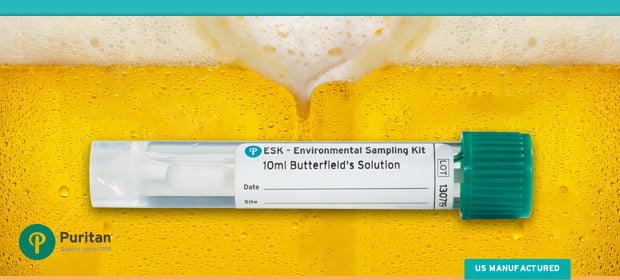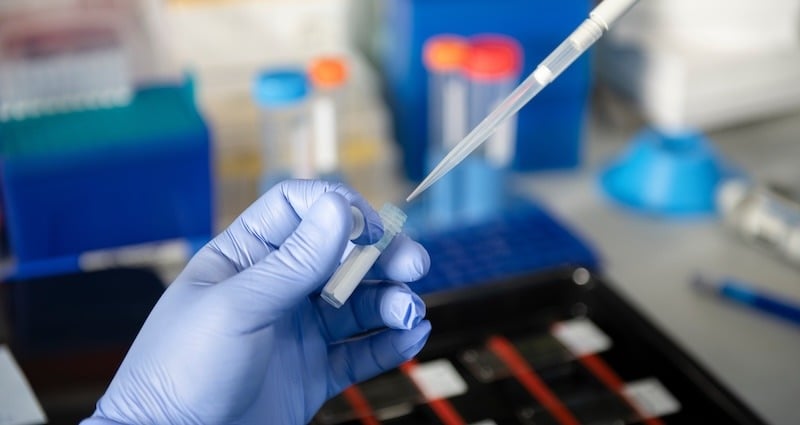
Established restaurants and breweries take food safety very seriously. But hobbyist home brewers and new micro brewers may not have access to the food safety testing information they need to ensure they’re brewing clean beer.
Sanitation is essential to producing the best product possible, and as Oktoberfest approaches, more and more small-scale breweries are ramping up their production, and thus, their sanitation procedures.
In fact, sanitation is so vital that, “most brewers spend their first several months of their career just learning to clean, before they are ever trusted with brewing,” said Jim Kuhr, brewmaster and director of brewery operations and for F.X. Matt Brewing Company, the brewery behind the popular Saranac brand.
So, have you ever wondered what goes into preventing contamination at breweries?
Swab to Validate Brewery Cleanliness
Though every facility will implement their own sanitation and quality control procedures, Puritan Medical Products produces a range of bacterial swabs and environmental sampling kits which may be appropriate for food safety testing in microbreweries or home production facilities.
While many home brewers tend to worry about yeast, it’s bacteria, specifically lactobacillus bacteria, that's the most common form of contamination in breweries. According to Suzanne Berens, author of “Prevent Contaminated Beer: Tips from the Pros,” unclean lines are the most common reason that bacteria will develop, and the heat exchanger has the greatest potential for harboring bacteria.
One of the easiest ways to validate the food safety procedures at your home or microbrewery is to swab for bacterial growth in areas through which the beer must pass. Morebeer.com recommends "swabbing all areas which should be clean and sterile, including: cleaned-in-place fermenter hose ends, exit ports from hard piping, the plate cooler, or the filter." You may also want to consider swabbing keg interiors and filling heads.
Causes of Bacterial Contamination in Breweries
During the grain malting process, cereal grains are germinated and dried. The starches are then converted to sugars, which are gradually consumed by yeast as the beer ferments and becomes alcoholic.
Not surprisingly, this high-sugar environment is extremely attractive to bacteria, who may thrive and multiply; potentially ruining a batch, or worse, contributing to the contamination of an entire facility. If you’re a small-scale vendor, that kind of contamination can end up costing you thousands of dollars in unusable product.
How to Swab for Bacterial Contamination in Breweries
-
Thoroughly wash hands and forearms up to elbow.
-
Apply gloves or other personal protective equipment.
-
If using dry swab, unwrap from packaging and add a few drops of sterile saline solution to swab tip.
-
If using a pre-moistened swab, unscrew cap and carefully remove swab, taking care not to touch swab tip against outside of vial.
-
Using firm pressure, swab an area no larger than 10 square centimeters, rotating the swab to ensure the entire tip has been exposed to sampling area.
-
Immediately place swab in transport medium and cap tightly.
-
Label all samples and place upright for storage.
-
Commence testing
How to Test Beer Swab Samples for Bacteria
You have a couple of options for testing. MoreBeer.com recommends incubating the swabs for 2-6 days at 75-80 degrees; periodically checking for any growth on the swab tips.
Brewingscience.com, on the other hand, recommends streaking exposed swabs across the surface to plated media, or adding 10ml sterile wort to the transport tube and allowing to incubate at 86 degrees for three days, and monitoring for growth. The method you choose should depend on the equipment you have access to.
Even small production facilities need to be mindful of their food safety practices. After cleaning and sterilization, take the time to extract a few swab samples of areas that you need to ensure are sterile. Identifying a potentially compromised batch or tool could save you thousands. And the peace of mind in knowing you've got a healthy facility? That’s priceless.
Want to learn more about using Puritan swabs for your food safety validation? Contact one of our knowledgeable product specialists today.
SOURCES:
-
Berens, Suzanne. Prevent Contaminated Beer: Tips from the Pros. Brew Your Own. The How-To Homebrew Beer Magazine. Retrieved September 12, 2014 from: https://byo.com/stories/item/1263-prevent-contaminated-beer-tips-from-the-pros
-
Donald, Tim. The Art Behind Quality Craft Beer. Food Quality & Safety magazine August/September, 2014. Retrieved September 12, 2014 from: http://www.foodquality.com/details/article/6523631/The_Art_Behind_Quality_Craft_Beer.html?tzcheck=1
-
Tveekrem, Andrew. Quality control for keg cleaning. probrewer.com. Retrieved September 5, 2014 from: http://www.probrewer.com/library/archives/quality-control-for-keg-cleaning/
-
Allen, Fal. The Microbrewery Laboratory Manual - Part II: Bacteria Detection, Enumeration, and Identification. Brewing techniques. Retrieved September 5, 2014 from: http://morebeer.com/brewingtechniques/library/backissues/issue2.5/allen.html
-
Brewers’ Laboratory Handbook: BREWING WITHOUT THE BLINDFOLD™. Retrieved September 5, 2014 from: http://www.brewingscience.com/PDF/BSI_brewers_lab_handbook.pdf
-
Malt. Wikipedia.org. Retrieved September 5, 2014 from: http://en.wikipedia.org/wiki/Malt





